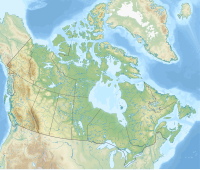| Phillipps Peak | |
|---|---|
 Phillipps Peak visible to the left behind Mount Tecumseh Phillipps Peak visible to the left behind Mount Tecumseh | |
| Highest point | |
| Elevation | 2,500 m (8,200 ft) |
| Listing | |
| Coordinates | 49°39′47″N 114°39′26″W / 49.66306°N 114.65722°W / 49.66306; -114.65722 |
| Geography | |
   | |
| Country | Canada |
| Provinces | Alberta and British Columbia |
| Parent range | High Rock Range |
| Topo map | NTS 82G10 Crowsnest |
Phillipps Peak is located north of Crowsnest Pass and straddles the Continental Divide marking the Alberta-British Columbia border. It was named in 1915 after Michael Phillipps who in 1873 was the first white man to cross Crowsnest Pass. It is the lower west peak of Mount Tecumseh.
Geology
Phillipps Peak is composed of sedimentary rock laid down during the Precambrian to Jurassic periods. Formed in shallow seas, this sedimentary rock was initially uplifted beginning 170 million years ago when the Lewis Overthrust fault pushed an enormous slab of precambrian rocks 3 mi (4.8 km) thick, 50 miles (80 km) wide and 160 miles (260 km) long over younger rock of the cretaceous period during the Laramide orogeny.
Climate
Based on the Köppen climate classification, Phillipps Peak has an alpine subarctic climate with cold, snowy winters, and mild summers. Temperatures can drop below −20 °C with wind chill factors below −30 °C.
See also
References
- ^ "Phillipps Peak". cdnrockiesdatabases.ca. Retrieved 2025-01-19.
- "Topographic map of Phillipps Peak". opentopomap.org. Retrieved 2025-01-19.
- ^ "Phillipps Peak [Alberta]". Geographical Names Data Base. Natural Resources Canada. Retrieved 2025-01-19.
- ^ "Phillipps Peak". BC Geographical Names. Retrieved 2025-01-19.
- Gadd, Ben (2008), Geology of the Rocky Mountains and Columbias
- Peel, M. C.; Finlayson, B. L.; McMahon, T. A. (2007). "Updated world map of the Köppen−Geiger climate classification". Hydrol. Earth Syst. Sci. 11: 1633–1644. ISSN 1027-5606.